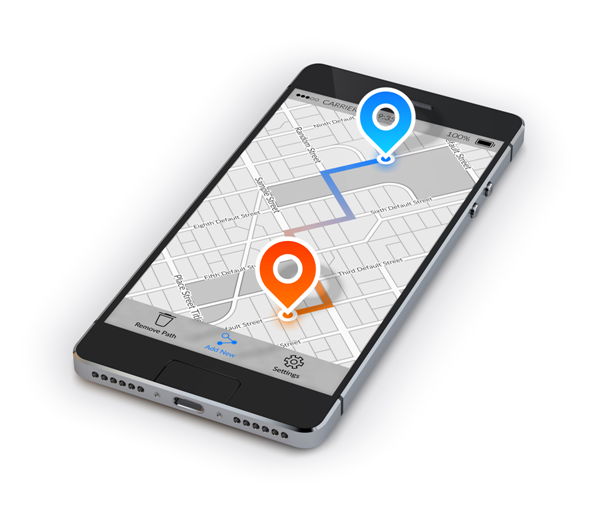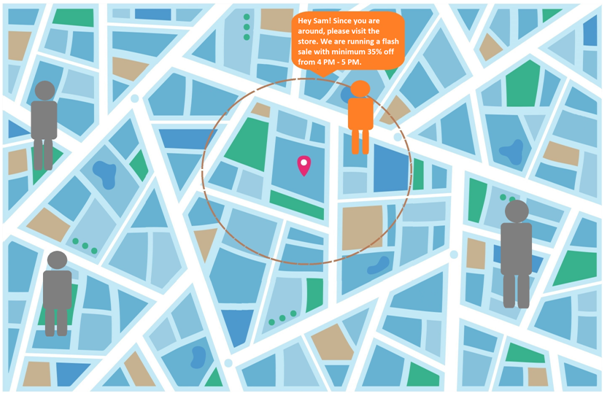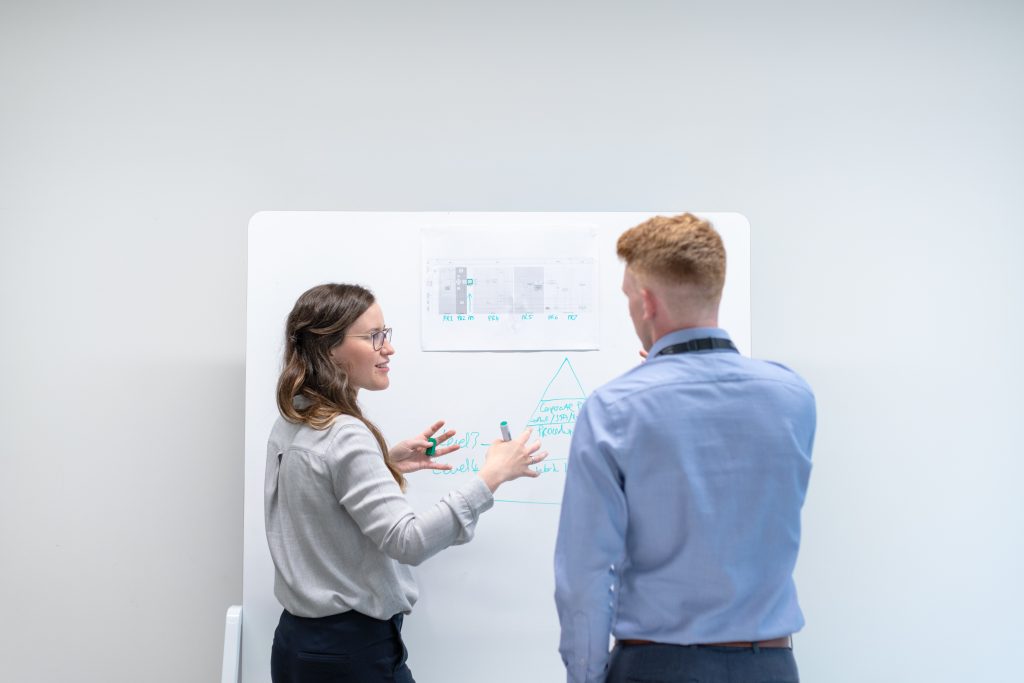Today the quick-service restaurant industries are leveraging advanced technologies to drive customers away from their competitors. Each quick-serve is constantly trying every marketing and advertising idea to gain a competitive edge in a crowded market. In this marketing technique, businesses and restaurants are playing with data navigation techniques such as location intelligence and geofencing to win over the customer.
Geofencing and location intelligence technology allow brands to understand their customer behavior, engage them and provide personalized experiences to their customers.
Many brick-and-mortar restaurants utilize geofencing and location intelligence technology in their mobile strategy to provide a unique customer experience that actually will enhance customer acquisition and retention rates.
What is Location Intelligence?
Following the rise of mobile innovation and marketing moxie, companies are using location intelligence technology for customer connections, compliance, and even worker safety.
Perhaps the cleverest use of location intelligence or location-based marketing is to provide superior customer engagement and experience by providing real value addition and convenience to its customers.
In essence, Location Intelligence is helping the restaurant and food-tech industries attract the attention of consumers, offering them tailored services and deals at the right time and right place.
This simple and fiendishly inventive marketing worked effectively in a highly competitive market, where fast-food chains are within proximity in densely populated areas and are putting every effort to poach their customers from their rivals.
Thus, many restaurant and food-tech giants are using real-time location to gain a better insight into the relative portion of the wallet, competitive store visits, and customer loyalty.
Introduction to Geofencing
As the name is self-explanatory, virtual geographic boundaries or fences around a physical location for more targeted mobile advertising and consumer businesses.
Going deeper, geofencing is a form of location intelligence that uses mobile GPS or RFID (Radio Frequency Identification) to generate a targeted marketing action like a text, email, social media advertisement, or app notification when a consumer’s mobile device or RFID tags crosses it. It is a robust method of marketing that allows businesses to deliver ads and content attuned to their consumers’ behavior and demands.

According to the report, the geofencing market accounted for the US $ 458.3 million in 2016 and, not surprisingly, is projected to reach $ 1.8 billion by 2022 at a compound annual growth rate (CAGR) of 27.5 percent.
It is important to note that geofencing doesn’t require hardware, instead it is software that integrates into any app and is managed through an online dashboard or API. The practice of geofencing relies on IoT devices, real-time IoT communications, and location intelligence and is managed in a modern Geographic Information System (GIS).
The main advantage of geofencing is to provide a contextual experience to the customer through personalization. In addition, if implemented properly, a geofencing strategy can be used in business intelligence, analysis, research, and even emergency warning systems.
Brands Optimizing Geofencing & Location Intelligence to Win CX
Reaching every potential customer is essential, and it can be challenging at times. But, with location intelligence & geofencing, restaurants have amplified their marketing strategies to catch consumer attention in an incredibly competitive market. Whatever the size, geofencing opens up innumerable opportunities and restaurants are taking advantage of these opportunities by offering happy hours or special promotions to customers within a specific range.
As an example of how this might work, let’s learn about some brands that have adapted location intelligence and geofencing technology to win CX.
Burger King
Burger King, a giant food tech, uses geofencing and location intelligence technology to steal customers from its rival McDonald’s. By utilizing location-based marketing, Burger King had launched a “Whopper Detour” campaign, which boosted downloads of its mobile app by 1.5 billion.
Under this campaign, customers within 600 feet of McDonald’s location and with the upgraded app were allowed to order a Whopper for just one penny. In this way, Burger King efficiently wins the customer by unlocking the $ .1 deal and redirecting them to the nearest outlet to claim the food.
Whenever a customer places an order outside the outlet, the app or software starts tracking the customer’s location. As the customer gets closer to the outlet, the app alerts employees to prepare the order, so that when the customer arrives at the store to pick it up, the food is not only ready but also hot.
McDonald’s
McDonald’s in 2016 started testing geofencing in its mobile app to attract more customers. To reduce waiting for lines, congestion, and serving fresh and hot food, McDonald’s began integrating geofencing technology in its mobile app. After the success, McDonald’s decided to go with geofencing to increase foot traffic and enhance customer experience.
Starbucks
In the same vein, Starbucks is also experimenting with location marketing to score big on customer experience.
To lure customers with special offers and discounts, Starbucks is using customer real-time location to notify them about special hours. Such marketing tactics help Starbucks to leave a long-lasting impression on its customers.
Geofencing and Location Intelligence for Restaurants
Geofencing and location intelligence can work for any restaurant, regardless of the type of food it serves. Both Android and iOS allow restaurateurs to create virtual boundaries around that geographical location they want to monitor.
Such virtual boundaries provide the restaurant owner with a real-time location of the customer and ensure that the carryout order will be warm and ready by the time the customer arrives. This enhances the customer experience (CX) and helps restaurants save operating and delivery costs.
· In short, geofencing works with location intelligence parameters such as latitude, longitude, and radius to create a virtual boundary around a predetermined location of a restaurant.
· Therefore, when a customer crosses that virtual boundary, their location data is used by that particular restaurant as part of a marketing campaign to send them highly relevant and personalized messages.
· The restaurant starts triggering alerts to the user via notification, in-app ads, or coupons.
· These alerts may contain promotions, discounts, and invitations just to lure the customers.
· Geofencing allows restaurants or cafes to track how often customers return and how long they stay in their geofenced area, without interrupting them with the notifications.
Helps Restaurants to Win CX
Post this COVID 19 pandemic, restaurants are redefining their business models and finding new ways to serve their customers. With safety protocols in place, restaurants are switching to contactless takeaway and pickup.
To avoid touching the physical menu, customers have started placing orders using the mobile app, with most even considering drive-through to be a safer option for taking orders. Restaurant businesses have analyzed that to keep their door open they must integrate geofencing and location intelligence technology into their system for a contactless approach to customers.
Today, geofencing has proven to be an incredibly effective and powerful location-based marketing tool in revolutionizing the restaurant market and engaging with its customers.
Streamlines the Takeaway Experience
With the real-time location of customers, restaurants can monitor customer’s foot traffic patterns en-route to their restaurant. Thus, geofencing provides restaurants with a convenient and cost-effective takeaway experience by triggering alerts about the location of customers and when to fire up the order.
For customers too, geofencing has streamlined the takeaway experience to make it fast and efficient by reminding them to start the restaurant journey at the optimal time, depending on how far they are.
Reduce Wait Lines and Serve Fresh Food
Serving fresh food to customers without standing in long queues was a dream for many quick-serving restaurants. But with geofencing and location intelligence, restaurants are now sure that their carryout order will be hot and ready by the time the customer arrives. With the geofencing integrated app, customers can create orders anywhere and pay for them through the app upon arrival. Thus, reducing waiting lines, cold food, and customer congestion and providing a luxurious and personalized experience for customers.
Help Boost Customer Retention
Whether it is through launching a new menu item, promoting a weekend special or happy hours, or organizing events, customer retention is the single most important factor to the success of a food business. By creating individual and personalized campaigns powered by geofencing technology, restaurants engage with users at the right time and in the right place to deliver customer delight. This leads to more adoption of mobile apps and an increased number of active users.
The restaurant can earn loyalty cards or points by giving them some extra reward points depending on the customer’s location, for example by rewarding them with special coupons or discounts when they enter a geofenced area or parking lot. This boosts customer retention and loyalty.
Provide Personalized Experience
Despite the increasing popularity of restaurant delivery, many restaurants faced hard times in providing personalized experiences to their customers. Experimenting with geofencing gives them better delivery analytics and smarter marketing campaigns resulting in more personalized experiences and customer engagement.
The truth in a nutshell is that the customer appreciates the people who receive them. With geofencing capabilities, restaurants can creatively serve customers with personalized emails and texts, and promotional coupons.

Given that personal experience is the most important factor in the success of the food business, it should be widely recommended as a great tool to engage customers.
Improve Customer experience
Creating a superior customer experience is the key to acquiring new customers and turning them into regular customers. Many restaurants have gained potential customers by locating them on the go and serving them better. With integrated geofencing and location intelligence technology, restaurants can alert customers and delivery partner executives to minimize long wait times.
In addition, through location data and analytics, restaurants are coming up with more creative campaigns keeping a better understanding of their potential customers’ behavior. These provide a seamless experience that will keep customers away from competitors and keep loyal customers happy.
Cost-effectiveness
Location intelligence & geofencing enable restaurants of any size and type to reach local people around their location. Being a low-cost marketing strategy, it produces excellent results as it gives the best chance to communicate with local customers who are likely to visit the restaurant.
Best Way to Reach Target Customer
Today IoT and smart devices have completely changed the landscape of targeted marketing. Businesses are using smartphones as the best way to get connected with their potential customers.
Geofencing has made it easier to reach the target audience at the right time and lengthen the buying cycle. Through geofencing, restaurants can attract customers’ attention by simply informing them about their products or services without any effort and enticing them with great deals and offers.
Increased Sales
Geofencing increase local sales by sending personalized advertising and promotions entering the restaurant territory with limited-time offers. For instance, restaurants may use push notifications to promote special offers or send alerts about the add-on menu. This further helps restaurants re-engage their customers who have become dissatisfied over time.
Immediate Customer Feedback
Geofencing is highly beneficial for CX-focused restaurants that really want real-time feedback from their customers. This technology enables customers to respond instantly via smartphones.
The feedback given will help the restaurant retain its existing or new customers by triggering an apology message with special offers. All this data is highly valuable for CX-centric restaurants.
Geofencing and location intelligence have become increasingly popular in the local marketing realm. With geofencing, start-ups that come with their own unique set of constraints can reduce noise and reach potential customers within a limited budget.
Geofencing and location intelligence are invaluable when it comes to providing a valuable personalized customer experience. With countless benefits, it has become an increasingly well-known tool in the successful marketing strategy of restaurants.
Today many restaurants, even startups, are actively integrating this technology in their mobile ordering systems and restaurant software to win CX, boost acquisitions and retention while building brand loyalty and affinity.
If you are looking for assistance in creating an exceptional customer experience for your restaurant business, you can reach our Kilowott’s Consulting and Strategy experts for a free consultation.





